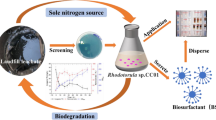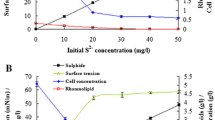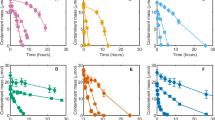Abstract
The selectivity of Rhodococcus sp. strain JVH1 among selected sulfidic and thiophenic compounds was investigated in both single-liquid-phase (aqueous) cultures and in two-liquid-phase cultures, where the sulfur compounds were dissolved in 2,2,4,4,6,8,8-heptamethylnonane as the immiscible organic carrier phase. In the single-liquid-phase cultures, Rhodococcus sp. strain JVH1 showed a preference for benzyl sulfide over both 1,4-dithiane and benzothiophene. An increased lag was observed in the degradation of benzyl sulfone and benzothiophene sulfone when both compounds were present. These results were consistent with a competitive inhibition mechanism, affecting both sulfur oxidation and carbon–sulfur bond cleavage. In the two-liquid-phase cultures, the effect of partitioning between the two liquid phases dominated the desulfurization activity of the culture. This partitioning resulted in an apparent absence of selectivity, as well as decreases in lag time, extent of degradation, and time to completion of degradation. Desulfurization activity also depended on the growth phase of the cultures. Mass transfer rate limitations were not observed at the low degradation rates of 0.02 mmol day-1 l−1. Owing to the importance of partitioning, Rhodococcus sp. strain JVH1 is predicted to show nonselective activity towards the sulfur species in a whole crude oil.





Similar content being viewed by others
Abbreviations
- HMN:
-
2,2,4,4,6,8,8-Heptamethylnonane
References
Andersson JT, Schräder W (1999) A method for measuring 1-octanol–water partition coefficients. Anal Chem 71:3610–3614
Bressler DC, Gray MR (2003) Transport and reaction processes in bioremediation of organic contaminants. 1. Review of bacterial degradation and transport. Int J Chem Reactor Eng 1:R3
Bressler DC, Leskiw BK, Fedorak PM (1999) Biodegradation of benzothiophene sulfones by a filamentous bacterium. Can J Microbiol 45:360–368
Déziel E, Comeau Y, Villemur R (1999) Two-liquid-phase bioreactors for enhanced degradation of hydrophobic/toxic compounds. Biodegradation 10:219–233
Efroymson RA, Alexander M (1995) Reduced mineralization of low concentrations of phenanthrene because of sequestering in nonaqueous-phase liquids. Environ Sci Technol 29:515–521
Fedorak PM, Coy DL, Salloum MJ, Dudas MJ (2002) Methanogenic potential of tailings samples from oil sands extraction plants. Can J Microbiol 48:21–33
Interactive LogKow (KowWin) Demo (2005) Syracuse Research Corporation. http://www.syrres.com/esc/est_kowdemo.htm. Cited 15 Dec 2005
Kirkwood KM (2006) Bacterial attack on aliphatic sulfides and related compounds representing the sulfur groups in heavy crude oil. Ph.D. thesis, University of Alberta
Kirkwood KM, Ebert S, Foght JM, Fedorak PM, Gray MR (2005) Bacterial biodegradation of aliphatic sulfides under aerobic carbon- or sulfur-limited growth conditions. J Appl Microbiol 99:1444–1454
Mutnuri S, Vasudevan N, Kaestner M (2005) Degradation of anthracene and pyrene supplied by microcrystals and non-aqueous-phase liquids. Appl Microbiol Biotechnol 67:569–576
Strausz OP, Lown EM (2003) The chemistry of Alberta oil sands, bitumens and heavy oils. Alberta Energy Research Institute, Calgary, Alta
Van Hamme JD, Fedorak PM, Foght JM, Gray MR, Dettman HD (2004) Use of a novel fluorinated organosulfur compound to isolate bacteria capable of carbon–sulfur bond cleavage. Appl Environ Microbiol 70:1487–1493
Acknowledgements
This work was supported by NSERC and by the Alberta Energy Research Institute through the COURSE program. Rhodococcus sp. strain JVH1 was provided by the National Centre for Upgrading Technology. We also thank Sara Ebert for experimental assistance, and Debbi Coy for help with the acetate analyses.
Author information
Authors and Affiliations
Corresponding author
Rights and permissions
About this article
Cite this article
Kirkwood, K.M., Foght, J.M. & Gray, M.R. Selectivity among organic sulfur compounds in one- and two-liquid-phase cultures of Rhodococcus sp. strain JVH1. Biodegradation 18, 473–480 (2007). https://doi.org/10.1007/s10532-006-9080-8
Received:
Accepted:
Published:
Issue Date:
DOI: https://doi.org/10.1007/s10532-006-9080-8




